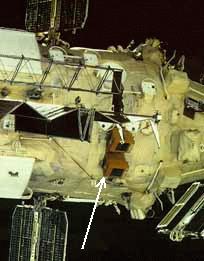
Experiment Neutral-E
(COLLISA)
The registration of the interstellar atoms
onboard the MIR station.
onboard the MIR station.

Full images are 57KB and 105KB

|
Experiment Neutral-E
onboard the MIR station. |

|
| Images: by courtesy of NASA Full images are 57KB and 105KB |
The aim of the astrophysical experiment "Neutral-E" is investigation of the isotopic composition of the neutral gases He and Ne in the interstellar medium. The method uses metal foils which collect the infalling atoms, then are brought back to Earth for mass-spectrometric analysis.
This problem - isotope composition of the interstellar gas - remains
practically unsolved up to date. In fact optical (spectroscopical)
methods can give the data only on the element composition of the
interstellar matter. The pioneer works in study of scattering of
ultra-violet solar radiation on neutral atoms in the near-earth space
allowed to discover only interstellar atoms of 4He, while
other components haven't been registered. Only recently, the SWICS
mass-spectrometer on the ULYSSES spacecraft was able to detect
3He interstellar atoms as well. With wide error limits, the
20Ne/22Ne isotopic ratio was estimated
indirectly from analyses of the anomalous cosmic radiation (ACR).
First of all observation of He and Ne isotopes of interstellar origin
is of particular interest due to the fact that both components being
inert gazes do not act in chemical reactions, and their isotope
composition does not change in different fractional processes. So, the
history of their origin is "frozen" in their isotope
composition.
According to the common hypothesis, helium isotopes (4He and 3He) were born at the time of the "Big Bang" which put the beginning to the Universe observed. After that the isotope 3He supplementarly arose in nuclear reactions occurring in stars. Exploded or dispersed stars have enriched the interstellar gas with 3He.
For Protosun matter the ratio 3He/4He is known from the analysis of meteorites and observation of the solar flares and the solar wind. One can suppose that this ratio fixed the state of the interstellar medium for the epoch of Solar System formation - about 4,6 billions years ago. So, today we expect to obtain for the interstellar gas the higher ratio of 3He/4He which would show the intensity of stars birth and death processes have taken place after the formation of the Sun.
The isotope ratio 20Ne/22Ne also depends greatly on the "nuclear" history of the matter. Up to now different measurement tests (meteorites, stones from the Moon, solar flares and solar wind) have given substantially different results for this ratio, which remains unexplained. Acquisition of such ratio for the interstellar medium has to be the main basis for further analysis.
One should underline that the registration of the neutral atoms of the interstellar medium with in-situ technique will open the new source of knowledge about processes taking place outside the Solar System.
The principal basis of the "Neutral-E" experiment is to trap (to absorb) neutral atoms of an interstellar medium on the surface of metal foil with their following evaporation and precise mass-spectrometric analysis.
To carry out this experiment specially prepared samples of foil must be exposed in the open space, being sufficient (for ~100 hours) in the interstellar gas flow, atoms of which will be partly absorbed by the foil. After the exposition the samples of the foil must be returned to the Earth where they will undergo special mass-spectrometer analysis for separation of the components under study: 4He, 3He, 20Ne and 22Ne.
The offered method of the registration of atoms of inert gases using absorbtion by the metal foil with further laboratory analysis has rather long history and has been successfully checked up in lots of experiments, carried out by the scientists from Physical Institute of University of Bern (Switzerland) - PHYBE.
In the "Neutral-E" experiment (the English acronym is "COLLISA", for COLLection of InterStellar Atoms) the exposition of the samples of foil and all necessary operations are fulfilled on board the MIR station using the instrument "KOMZA" (Russian acronym for the interstellar atoms collector). This instrument has been specially made by the specialists of Space Research Institute (IKI) with participation of the Space Physics Design Bureau. The basis of this device is the replaceable cassette with the sample of foil, that must be exposed. These samples were prepared and assembled by PHYBE specialists.
Two KOMZA instruments were mounted onboard the module SPECTR which was docked to the MIR station at the June 1, 1995 - see Fig.1 above.
The scheme of KOMZA instrument is shown on Fig.2

1. To carry on long exposition of the foil samples.
2. To provide occasional service of the device (to change the
cassettes) i.e. to expose several samples.
3. To return the cassettes with the exposed foil to the Earth.
The flux of the interstellar gas at the orbit of the Earth is small. The estimated concentration of 4He atoms inside the heliosphere, but far from the Sun, is about 0.01 cm-3; the concentration of 3He is approximately 4500 times smaller, and the concentration of Ne is expected to be 2 to 3 orders of magnitude smaller then for He.
The principal opportunity of registration of these atoms is connected with the fact, that the speed of their relative motion to the space device on the near-Earth is rather high - from 20 to 70 km/s. Consequently, the flux of interstellar atoms far from the Sun is about 3*104 particles/cm2/s for 4He atoms, and is much smaller for 3He and neon atoms.
The gravitational attraction of the Sun increases the fluxes by its focusing action, but the loss by UV ionization in the Sun's vicinity deplets the fluxes of the neutral atoms by a similar factor.
That's why for obtaining reliably detectable quantities of needed atoms the experiment "Neutral-E" requires, first of all, rather large square of the detector (hundreds of square centimeteres) and, next, rather large total exposition time (hundreds of hours).

Small concentration value of interstellar atoms under examination leads to the fact that experiment turns out extremely sensible to any pollution on the spacecraft. Evaluations made on experimental data we have for MIR station and on model calculations, show that under fixed (background) conditions the pollution of the foil by a stream of atoms and molecules released by walls and framework elements of the station doesn't exceed permissible level if there is no straight line from the surface of a cassette with foil to these walls (frameworks). The last fact leads to some limitations in choosing the place for our instruments on module SPECTR and the width of its angular acceptance.
On the other side, during dynamic operations aboard the station (docking or undocking, turning on the engines, moments when cosmonauts exit the station, etc.) density of station's atmosphere and concentration of hydrocarbons in it had increased so much that it could substantially diminish absorbing capability of the foil for interstellar atoms (for example, by forming monolayer of polymer molecules). To prevent such kind of pollution the instrument was equipped by special shutters (see Fig.2) controlled by command and safely overlapping the input window. Introduction of the shutters opening only at desirable moments profitably makes this instrument different from the analogous ones that were used in previous experiment aboard the American LDEF satellite. To prevent a possible influence of the magnetospheric He ions a grid with a high-voltage retarding potential (+6kV) was mounted inside the KOMZA instrument.
Nowadays there are two identical units of KOMZA instrument operating successefully on MIR station.
The control of KOMZA instrument is fully provided by ENERGIA specialists (Russian Rocket-Space Corporation ENERGIA) under the contract with Russian Space Agency. Time intervals and the attitude of working exposition are calculated by IKI and PHYBE specialists. The exchange of cassettes is provided by cosmonauts during their activity in outer space. The delivery and returning of cassettes are fulfilled by American space ship Atlantis except the first set of cassettes which was assembled before SPECTR launching on the Earth.
During the period of August - October 1995 the instrument was tested and the first (background) exposition was realized. Total durations of the 1st exposition were about 70 hours. The first changing of the cassettes was fulfilled in October 20, 1995 during the outvehicle activity of cosmonauts S.Avdeev (Russia) and T.Reiter (ESA).
The next (working) exposition cycles were carried out in accordance with the conditions of the experiment from January till May of 1996. Total duration of of this exposure was 55 hours. The second change of the cassettes was done by cosmonauts Yu.Onuphrienko and Yu. Usachev (Russia) on June 6, 1996.
In both cases the exposed cassettes were returned to the Earth and were passed over to the IKI. Now the scientists of PHYBE (under the supervision of the Swiss National Sciences Foundation) in co-operation with IKI perform the processing and analysis of the obtained samples. This work is in progress.
Since January, 1997 the exposition of third set of cassetes was begun. It was continue till the May, 1997, but because of some technical problems of MIR station in this year total duration of the exposure 1997 was only 7.5 hours.
All questions about "Neutral-E" (COLLISA) experiment should
be forwarded to
Dr. Georgy Zastenker (scientific coordinator of the COLLISA project)
gzastenk@iki.rssi.ru
Dr. Fritz Buehler (project scientist from PHYBE side)
FBUEHLER@phim.unibe.ch
All questions about KOMZA instrument should be forwarded to
Ing. Yurii Agafonov (project manager)
yagafonov@romance.iki.rssi.ru
Manager of control operations with KOMZA instrument at RRSC ENERGIA is
Ing. Nikolaj Shvets
 Back to the Space Research Institute (IKI) Home Page
Back to the Space Research Institute (IKI) Home Page